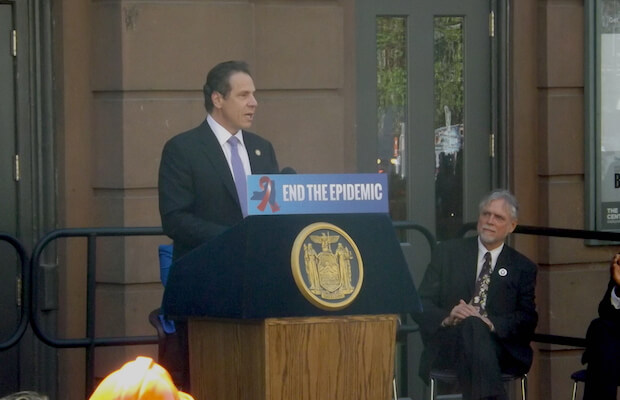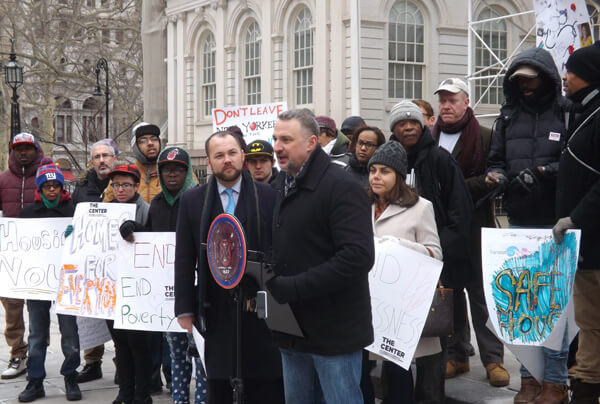Confronted with an outbreak of meningitis among gay and bisexual men in September 2012, New York City’s health department appears to have struggled to respond to the disease in the early months of the outbreak.
“We have two recent cases of [meningitis] in MSM who likely had contact with each other about a month apart and we are recognizing that MSM is an emerging risk factor for [meningitis] here in NYC,” wrote Don Weiss, who heads the communicable disease surveillance unit at the city health department, in a September 20, 2012 email. “Since August 2010 we’ve had 9 known cases in MSM, 2 of which were also known to have HIV… We are holding a inter-bureau meeting on Monday to discuss the data and strategies, possibly issuing [meningitis vaccine] recommendations for the NYC MSM HIV community.”
That Weiss email was the city’s first communication with the federal Centers for Disease Control and Prevention (CDC) that discussed the outbreak. On September 27, the city’s Department of Health and Mental Hygiene (DOHMH) issued a press release saying it had seen four meningitis cases among men who have sex with men (MSM) in the prior four weeks. In a separate alert sent to healthcare providers that same day, the department said it knew of 12 cases since August of 2010.
Health department sought technical advice, voiced doubt about its vaccine plans, potential benefits
Gay City News obtained emails and other records related to the outbreak from the CDC under the Freedom of Information Act. The records are dated from September 20, 2012 to January 4, 2013.
The same day that the DOHMH issued the two statements, Jay Varma, the deputy commissioner for disease control at the DOHMH, wrote CDC asking about the “benefits of vaccination in interrupting transmission, particularly among HIV-infected individuals.”
Varma also asked about any epidemiological data on meningitis among “HIV-infected adults” and whether “anti-biotic prophylaxis” was useful in fighting the bug. He noted that the health agency was buying vaccine.
“We’re ordering about 1,000 doses of [vaccine] to start with,” he wrote. “Hoping to have defined a group that might benefit from vaccination tonight.”
The DOHMH did not initially recommend vaccinations. In early October of 2012, it recommended that HIV-positive, sexually active gay and bisexual men get vaccinated, and in November it expanded that recommendation to include all sexually active gay and bisexual men regardless of HIV status.
Though it initially said it wanted to vaccinate 10,000 men, the DOHMH bought 4,000 doses in 2012. The vaccination target grew to between 30,000 and 100,000 in 2013. The DOHMH bought another 8,000 doses in 2013.
In an October 12 email, Varma wrote to CDC again, saying, “Vaccine uptake relatively slow so we’ll be driving demand with a social marketing campaign to start in next 2 weeks.”
The outbreak eventually grew to 22 cases, with a 23rd case upstate, and seven deaths. The last case was seen in February.
This was not New York City’s first meningitis outbreak, and it had seen the specific bug causing the outbreak among gay and bisexual men before.
In 2006, the city health department saw a 23-case meningitis outbreak among drug injectors in Central Brooklyn that killed seven people. Between June 28 and September 30 of that year, the department vaccinated 2,763 people. Three additional cases were seen after the campaign. Weiss was the lead author on a study on the Brooklyn outbreak that was published in 2009.
The August 2010 case, part of the more recent outbreak, was 100 percent identical to the bug that caused the earlier Brooklyn outbreak, according to a DOHMH PowerPoint presentation that was written by Weiss and was among the CDC records. The DOHMH first learned of the match in September 2012.
Among three cases that occurred in August 2011, one was 91 percent identical to the Brooklyn bug and another was 82 percent identical. The third case was listed as “n/a” under “Strain similarity to 2006.” The DOHMH learned of those similarities in October of 2011. Among epidemiologists, a greater than 85 percent match indicates that the two strains are the same.
The presentation had data on genetic matching for four 2012 cases and reported that two were 90 percent identical to the 2006 strain, one was 88 percent identical, and the fourth was 92 percent identical. The rate at which the cases were initially occurring did not qualify them as an outbreak, which has a specific definition.
“The occurrence of one case, even one that has the same molecular fingerprint as an earlier outbreak, does not necessarily portend a future outbreak,” the DOHMH wrote in an email to Gay City News. “In September 2012, we had sufficient evidence to indicate that the [meningitis] strain was circulating exclusively in a new risk group (MSM) and causing a high rate of death among HIV-infected MSM, prompting us to notify the public and recommend vaccination.”
It was at that point that the health department judged that the cases constituted an outbreak.
Two other North American cities that had meningitis outbreaks among gay men responded faster.
Two of six gay men with meningitis in Toronto died in an outbreak from “early May to mid-July of 2001,” according to a 2003 study. Toronto health officials administered 3,850 vaccine doses free of charge in 50 locations, including bathhouses and a community center, from July 25 through August 18 of that year. Toronto saw no additional cases.
An October 2003 outbreak in Chicago that killed three of six infected gay men led to an eight-day vaccination campaign that administered 14,267 doses at six sites, according to a 2007 study. There were no new cases there.

































